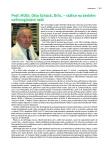Plasma and salivary markers of oxidative and carbonyl stress in patients with acute intermittent porphyria
Authors:
Miroslav Mydlík 1,2; Katarína Derzsiová 1; Ivana Koborová 3; Katarína Šebeková 3
Authors‘ workplace:
IV. interná klinika LF UPJŠ v Košiciach a UN L. Pasteura Košice, Slovenská republika
1; Ústav experimentálnej medicíny LF UPJŠ v Košiciach, Slovenská republika
2; Ústav molekulárnej biomedicíny LF UK v Bratislave, Slovenská republika
3
Published in:
Vnitř Lék 2016; 62(Suppl 6): 25-29
Category:
Original Contributions
Overview
Background:
Acute intermittent porphyria (AIP) is an autosomal inherited disease caused by deficiency of the third enzyme in the heme biosynthetic pathway, porphobilinogen deaminase. The clinical course of the disease is characterized by acute attacks, most often with abdominal pain.
The aim of our study was to investigate selected markers of oxidative and carbonyl stress in plasma and saliva in patients with AIP and to find out whether saliva could be used for monitoring the disease progression. Saliva is an attractive biological fluid for determination of biochemical markers in various pathological conditions. The advantage is that saliva can be collected non-invasively, and the examination needs only a small volume of saliva.
Methods:
Blood and total non-stimulated saliva were collected from 16 patients with AIP in remission, and from 20 healthy individuals. Markers of oxidative and carbonyl stress – advanced glycation end products (AGEs), and thiobarbituric acid reacting substances (TBARS) were determined by spectrofluorometric methods, advanced oxidation protein products (AOPPs), total antioxidant capacity (TAC) and ferric reducing ability of plasma/saliva (FRAP/FRAS) were investigated by spectrophotometric methods in the above mentioned groups.
Results:
Advanced glycation end products and thiobarbituric acid reacting substances in plasma and saliva were significantly higher in patients with AIP in comparison to the control group (p < 0.001) and (p < 0.05). Advanced oxidation protein products in AIP if compared to the control group did not show statistical significance (p > 0.05), but the levels in the saliva were significantly lower (p < 0.001). The concentrations of markers of antioxidant status of plasma and saliva were significantly lower in AIP if compared to the control group (p < 0.001).
Conclusions:
According to the best of our knowledge this is the first study to demonstrate increased concentrations of markers of oxidative and carbonyl stress and decreased antioxidant status of plasma and saliva in patients with AIP. Moreover, the study suggests that the saliva might be a promising fluid to study relevant biomarkers in a wide array of human biomedical conditions.
Key words:
acute intermittent porphyria – biomarkers – oxidative and carbonyl stress – plasma and saliva
Sources
1. Besur S, Schmeltzer P, Bonkovsky HL. Acute porphyrias. J Emergency Med 2015; 49(3): 305–312. Dostupné z DOI: <http://dx.doi.org/ 10.1016/j.jemermed.2015.04.034>. 2. Mydlík M, Derzsiová K, Legáth Ľ et al. Klinické a biochemické poruchy pri akútnej intermitentnej porfýrii a porfýrii variegata. Interná Med 2016; 16(2): 58–62. 3. Ventura P, Capellini MD, Rocchi E. The acute porphyrias: a diagnosis and therapeutic chalenge in internal and emergency medicine. Int Emerg Med 2009; 4(4): 297–308. Dostupné z DOI: <http://dx.doi. org/10.1007/s11739–009–0261–4>. 4. Sardh E, Harper P, Andersson Dan EH et al. Plasma porphobilinogen as a sensitive biomarker to monitor the clinical and therapeutic course of acute intermittent porphyria attacks. Europ J Intern Med 2009; 20(2): 201–207. Dostupné z DOI: <http://dx.doi.org/10.1016/j. ejim.2008.06.012>. 5. Kamodyová N, Tóthová Ľ, Celec P. Salivary markers of oxidative stress and antioxidant status: Influence of external factors. Disease Markers 2013; 34(5): 313–321. Dostupné z DOI: <http://dx.doi. org/10.3233/DMA-130975>. 6. Wang J, Schipper HM, Velly AM et al. Salivary biomarkers of oxidative stress: A critical review. Free Radic Biol Med 2015; 85 : 95–104. Dostupné z DOI: <http://dx.doi.org/104.10.1016 j.freeradbiomed.2015.04.005>. 7. Karlík M, Valkovič P, Hančinová V et al. Markers of oxidative stress in plasma and saliva in patients with multiple sclerosis. Clin Biochem 2015; 48(1–2): 24–28. Dostupné z DOI: <http://dx.doi.org/10.1016/j. clinbiochem.2014.09.023>. 8. Peluso I, Raguzzini A. Salivary and urinary total antioxidant capacity as biomarkers of oxidative stress in humans. Patholog Res Int 2016; 2016 : 5480267. Dostupné z DOI: <http://dx.doi. org/10.1155/2016/5480267>. 9. Mydlík M, Derzsiová K, Javorská K et al. Markery oxidačného a karbonylového stresu u hemodiafiltrovaných chorých. Interná Med 2015; 15(7–8): 324–328. 10. Mauzeral D, Granick S. The occurrence and determination of δ-aminolevulinic acid and porphobilinogen in urine. J Biol Chem 1956; 219(1): 435–446. 11. Kyselina 5-aminolevulová (ALA) / Porfobilinogén(PBG). Chromatografia – spektrofotometria. Biosystems Reagents & Instruments. Slovenský preklad: 2016. Dostupné z DOI: <http://www.jktrading.cz/mbfile - 11017-ala-pbg-1505.pdf> 12. Münch G, Keis R, Wesels A et al. Determination of advanced glycation end products in serum by fluorescence spectroscopy and competitive ELISA. Eur J Clin Chem Clin Biochem 1997; 35(9): 669–677. 13. Witko-Sarsat V, Friedlander M, Capeillere-Blandin C et al. Advanced oxidation protein products as a novel marker of oxidative stress in uremia. Kidney Int 1996; 49(5): 1304–1313. 14. Anderstam B, Ann-Christin BH, Valli A et al. Modification of the oxidative stress biomarker AOPP assay: application in uremic samples. Clin Chim Acta 2008; 393(2): 114–118. Dostupné z DOI: <http://dx.doi. org/10.1016/j.cca.2008.03.029>. 15. Benzie IF, Strain JJ. The ferric reducing ability of plasma (FRAP) as a measure of „antioxidant power“: the FRAP assay. Anal Biochem 1996; 239(1): 70–76. 16. Erel O. A novel automated direct measurement method for total antioxidant capacity using a new generation, more stable ABTS radical cation. Clin Biochem 2004; 37(4): 277–285. 17. Behuliak M, Palffy R, Gardlik R et al. Variability of thiobarbituric acid reacting substances in saliva. Dis Markers 2009; 26(2): 49–53. Dostupné z DOI: <http://dx.doi.org/10.3233/DMA-2009–0606>. 18. Mydlík M, Derzsiová K, Jenča A et al. Kyselina oxalová a askorbová v slinách pri chronickej renálnej insuficiencii. Akt Nefrol 2006; 12(2): 41–44.
Labels
Diabetology Endocrinology Internal medicineArticle was published in
Internal Medicine

2016 Issue Suppl 6
Most read in this issue
- Metabolic acidosis in chronic kidney disease
- Current options of treatment of hyponatremia
- Gitelman´s syndrome as common cause of hypokalemia and hypomagnesemia
- Osteoporosis – epidemiology and pathogenesis
